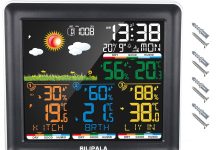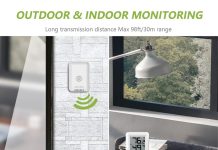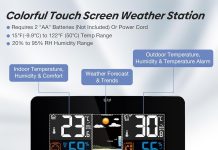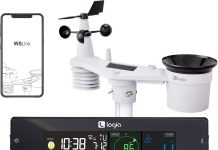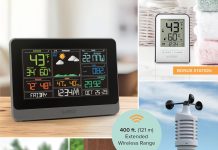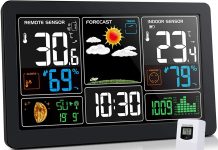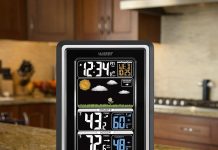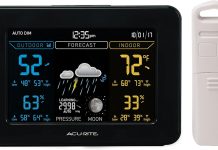If you’re the proud owner of a home weather station, you’re likely eager to dive into the abundance of data it collects. But how do you make sense of all those numbers and charts?
Luckily, there is a wide range of user-friendly software available that can help you analyze and visualize the data from your weather station, allowing you to gain valuable insights and make informed decisions about the weather conditions in your area.
In this article, we’ll explore some of the top software options that make it a breeze to unlock the full potential of your home weather station data.
Software options for analyzing and visualizing data from a home weather station
When it comes to analyzing and visualizing data from your home weather station, several software options can help you make sense of the information. This article will explore some of the most popular choices and discuss their features, pros, and cons. Whether you are an amateur weather enthusiast or a professional meteorologist, you will find a software solution that meets your needs.
Excel
Overview
Excel is a widely used spreadsheet program that can be a powerful tool for analyzing and visualizing data from a home weather station. With its familiar interface and robust functionality, Excel offers a flexible and customizable solution for weather data analysis.
Features
- Spreadsheet layout: Excel allows you to organize and manipulate your weather data in a tabular format, making it easy to perform calculations and create charts.
- Data visualization: Excel provides a range of chart types and customizable options to help you visualize your weather data effectively.
- Data analysis tools: Excel offers a variety of built-in functions and formulas that can be used to analyze your weather data, such as calculating averages, finding trends, and identifying outliers.
Pros
- Familiar interface: Many people are already familiar with Excel, making it easy to start and work with.
- Customizability: Excel allows you to tailor your analysis and visualizations to your needs and preferences.
- Integration with other tools: Excel can easily be integrated with other software tools or data sources, allowing for seamless data transfer and analysis.
Cons
- Steeper learning curve: While Excel is widely used and accessible, learning to use its more advanced features for weather data analysis may require additional effort.
- Limited scalability: Excel may not be the best option if you need to handle large amounts of data or perform complex calculations.
Weather Underground
Overview
Weather Underground is a popular online platform that provides weather data, forecasts, and analysis tools. It offers a range of features specifically designed for home weather station owners.
Features
- Data integration: Weather Underground seamlessly integrates with various weather station models, allowing you to upload and visualize your data directly on their platform.
- Data visualization: Weather Underground provides interactive maps, graphs, and charts that allow you to explore and analyze your weather data in a visually engaging way.
- Historical data access: Weather Underground offers access to historical weather data, which can be valuable for comparing current conditions with past trends.
Pros
- User-friendly interface: Weather Underground’s interface is intuitive, making it easy for anyone to access and interpret their weather data.
- Community features: Weather Underground has a strong user community, allowing you to connect with other weather enthusiasts and share your findings.
- Mobile app: Weather Underground offers a mobile app that allows you to access and analyze your weather data on the go.
Cons
- Limited customization: While Weather Underground provides a range of visualizations, customization options may be limited compared to other software solutions.
- Dependency on Internet connection: Weather Underground relies on an Internet connection to access and analyze your weather data, which may not be ideal in all situations.
Weatherlink
Overview
Weatherlink is a comprehensive weather station software developed by Davis Instruments. It offers a range of features designed to support home weather station owners and professional meteorologists.
Features
- Real-time data monitoring: Weatherlink allows you to monitor your weather data in real time, providing continuous updates on temperature, humidity, wind speed, and more.
- Data analysis tools: Weatherlink offers a variety of tools for data analysis, including the ability to generate graphs, calculate averages, and analyze long-term trends.
- Data sharing: Weatherlink provides options for sharing your weather data with others, including the ability to publish your data to various websites and social media platforms.
Pros
- Accurate and reliable: Weatherlink is well-known for its accuracy and reliability, making it a trusted choice for weather enthusiasts and professionals.
- Extensive compatibility: Weatherlink is compatible with a wide range of weather station models, ensuring you can use it regardless of your specific setup.
- Customer support: Davis Instruments offers excellent customer support for Weatherlink, providing assistance and troubleshooting when needed.
Cons
- Price: Weatherlink is a paid software solution, which may be a deterrent for some home weather station owners on a tight budget.
- Advanced features may require additional hardware: Some of the more advanced features of Weatherlink may require additional hardware or sensors, which can add to the overall cost.
Weather Display
Overview
Weather Display is a feature-rich software solution for home weather station owners. It offers a comprehensive set of data analysis, visualization, and reporting tools.
Features
- Customizable dashboard: Weather Display allows you to create personalized dashboards that display the most relevant weather data.
- Advanced graphing options: Weather Display provides a range of customizable graphing options, allowing you to create detailed visualizations of your weather data.
- Reporting capabilities: Weather Display allows you to generate detailed reports based on your weather data, making it well-suited for educational or research purposes.
Pros
- Extensive customization options: Weather Display offers a high level of customization, allowing you to tailor the software to your unique needs and preferences.
- Support for multiple weather station models: Weather Display is compatible with many weather station models, ensuring compatibility regardless of your setup.
- Active user community: Weather Display has an active user community that provides support and resources for new users.
Cons
- Learning curve: Weather Display has a steep learning curve, especially for users new to weather station software.
- Limited data sharing options: Weather Display may not offer as many options for sharing your weather data with others as other software solutions.
WeatherCat
Overview
WeatherCat is a software solution designed specifically for Mac users. It offers a range of features for visualizing and analyzing weather data from home weather stations.
Features
- Customizable dashboard: WeatherCat allows you to create personalized dashboards to display and monitor your weather data.
- Interactive graphs: WeatherCat provides interactive graphs that allow you to explore your weather data in detail, including the ability to zoom in and hover over data points for more information.
- Weather webcam integration: WeatherCat supports integration with weather webcams, allowing you to capture and visualize real-time images alongside your weather data.
Pros
- Mac compatibility: WeatherCat is explicitly designed for Mac users, ensuring optimal performance and integration with the operating system.
- User-friendly interface: WeatherCat offers an intuitive interface that is easy to navigate, making it accessible to users of all experience levels.
- WeatherCat.net community: WeatherCat has an active online community where users can share their experiences, ask questions, and access additional resources.
Cons
- Limited compatibility: WeatherCat is only compatible with Mac operating systems, which may disadvantage users with Windows or other operating systems.
- Price: WeatherCat is a paid software solution, which may deter some users from looking for a free or low-cost option.
Weatherview32
Overview
Weatherview32 is a Windows-based software solution for analyzing and visualizing data from home weather stations. It offers a range of features catering to amateur weather enthusiasts and professional meteorologists.
Features
- Real-time data monitoring: Weatherview32 provides continuous updates on various weather parameters, allowing you to monitor your weather data in real time.
- Customizable graphs and charts: Weatherview32 offers a variety of graphing options, giving you the flexibility to create visualizations that suit your needs.
- Weather cam integration: Weatherview32 supports integration with weather webcams, enabling you to view live images alongside your weather data.
Pros
- Compatibility with a range of weather station models: Weatherview32 is compatible with a wide range of weather station models, ensuring compatibility regardless of your setup.
- User-friendly interface: Weatherview32 features a user-friendly interface that makes navigating and accessing your weather data easy.
- Wide range of customization options: Weatherview32 offers extensive customization options, allowing you to tailor the software to your specific requirements.
Cons
- Limited platform compatibility: Weatherview32 is explicitly designed for Windows operating systems, which may limit its accessibility for users with other operating systems.
- Steeper learning curve: Weatherview32 may have a steeper learning curve than other software options, particularly for users new to weather station software.
WeatherSnoop
Overview
WeatherSnoop is a software solution that enables you to connect your home weather station to your Mac or iOS device. It offers a range of features that allow you to analyze and visualize your weather data easily.
Features
- Real-time data display: WeatherSnoop provides continuous updates on various weather parameters, giving you real-time access to your weather data.
- Customizable dashboards: WeatherSnoop offers customizable dashboards where you can arrange and display your weather data in a way that suits your preferences.
- Integration with home automation systems: WeatherSnoop can be integrated with popular home automation systems, allowing you to incorporate your weather data into your home’s innovative system.
Pros
- Mac and iOS compatibility: WeatherSnoop is designed to work seamlessly with Mac and iOS devices, providing an optimized user experience.
- User-friendly interface: WeatherSnoop features an intuitive interface that makes navigating and accessing your weather data easy.
- Home automation integration: Integrating WeatherSnoop with home automation systems adds more functionality to your weather station setup.
Cons
- Limited compatibility with weather station models: WeatherSnoop may have limited compatibility with specific weather station models, so it is essential to ensure your specific setup is supported.
- Price: WeatherSnoop is a paid software solution, and the cost may deter some users looking for a free or lower-cost option.
Virtual Weather Station
Overview
Virtual Weather Station offers a comprehensive software solution for analyzing and visualizing weather data from home weather stations. It provides a range of features catering to novice and experienced users.
Features
- Real-time data monitoring: Virtual Weather Station provides continuous updates on various weather parameters, allowing you to monitor your weather data in real time.
- Customizable visualizations: Virtual Weather Station offers various visualizations, including graphs, charts, and gauges, to help you analyze your weather data effectively.
- Historical data analysis: Virtual Weather Station allows you to access and analyze historical weather data, enabling you to identify long-term trends and patterns.
Pros
- Wide range of compatibility: Virtual Weather Station is compatible with various weather station models, ensuring compatibility regardless of your specific setup.
- Extensive data analysis options: Virtual Weather Station provides various tools and features for data analysis, allowing in-depth exploration of your weather data.
- User-friendly interface: Virtual Weather Station features an intuitive interface that is easy to navigate and understand, making it accessible to users of all experience levels.
Cons
- Price: Virtual Weather Station is a paid software solution, and the cost may be a consideration for users on a tight budget.
- Learning curve for advanced features: While Virtual Weather Station is user-friendly, users looking to explore its more advanced features may need to invest time in learning and understanding them.
PiWeatherRock
Overview
PiWeatherRock is a unique software option for analyzing and visualizing data from a home weather station precisely designed for Raspberry Pi devices. It offers a range of features that leverage the capabilities of these small single-board computers.
Features
- Raspberry Pi compatibility: PiWeatherRock is designed to work seamlessly with Raspberry Pi devices, allowing you to leverage their computing power for weather data analysis and visualization.
- Real-time data display: PiWeatherRock provides continuous updates on various weather parameters, allowing you to monitor your weather data in real time.
- Customizable visualizations: PiWeatherRock offers customizable weather displays, allowing you to choose the information that is most relevant to you and arrange it in a visually appealing way.
Pros
- Raspberry Pi integration: PiWeatherRock takes advantage of the computing power and flexibility offered by Raspberry Pi devices, providing a unique and customizable solution.
- Open-source community: PiWeatherRock is open-source software, which means that users can access and modify the code according to their needs, with support from the active Raspberry Pi community.
- Cost-effective solution: Raspberry Pi devices are relatively inexpensive, making PiWeatherRock an affordable option for home weather station owners.
Cons
- Limited compatibility: PiWeatherRock is explicitly designed for Raspberry Pi devices, which may limit its accessibility for users with other platforms.
- The steeper learning curve for beginners: Users new to Raspberry Pi devices may need to learn how to set up and configure PiWeatherRock for their specific needs.
In conclusion, there are several software options available for analyzing and visualizing data from a home weather station.
Whether you prefer the familiarity and flexibility of Excel, the comprehensive features of Weatherlink, or the user-friendly interfaces of Weather Underground and WeatherCat, there is a solution that meets your specific needs.
Take the time to explore the features and consider the pros and cons of each option to find the software that will best support your weather station setup and analysis goals.


